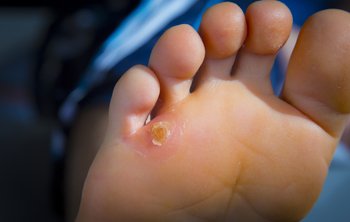3320 North Buffalo Drive
Suite 107
Las Vegas, NV 89129
 Corns are circular areas of raised, thickened skin that can usually be found on or around the toes. They are caused by repetitive friction over an area of skin. Corns can be soft or hard, depending on their location. Soft corns are more likely to form in between the toes, whereas hard corns are more likely to form on the tops or sides of toes. Corns may need medical attention if they are painful or if you have a medical condition like diabetes or a connective tissue disease. With your podiatrist’s approval, you may soak the corns in warm water and file them down with a pumice stone at home. You may also be prescribed a plaster to wear over the corn or a cream to apply to it to soften the thickened skin. For more information about corns, please consult with a podiatrist.
Corns are circular areas of raised, thickened skin that can usually be found on or around the toes. They are caused by repetitive friction over an area of skin. Corns can be soft or hard, depending on their location. Soft corns are more likely to form in between the toes, whereas hard corns are more likely to form on the tops or sides of toes. Corns may need medical attention if they are painful or if you have a medical condition like diabetes or a connective tissue disease. With your podiatrist’s approval, you may soak the corns in warm water and file them down with a pumice stone at home. You may also be prescribed a plaster to wear over the corn or a cream to apply to it to soften the thickened skin. For more information about corns, please consult with a podiatrist.
If you have any concerns regarding your feet and ankles, contact one of our podiatrists of Summerlin Foot & Ankle. Our doctors will treat your foot and ankle needs.
Corns: What Are They? and How Do You Get Rid of Them?
Corns can be described as areas of the skin that have thickened to the point of becoming painful or irritating. They are often layers and layers of the skin that have become dry and rough, and are normally smaller than calluses.
Ways to Prevent Corns
There are many ways to get rid of painful corns such as wearing:
Treating Corns
Treatment of corns involves removing the dead skin that has built up in the specific area of the foot. Consult with Our doctors to determine the best treatment option for your case of corns.
If you have any questions please feel free to contact our office located in Las Vegas, NV . We offer the newest diagnostic and treatment technologies for all your foot and ankle needs.